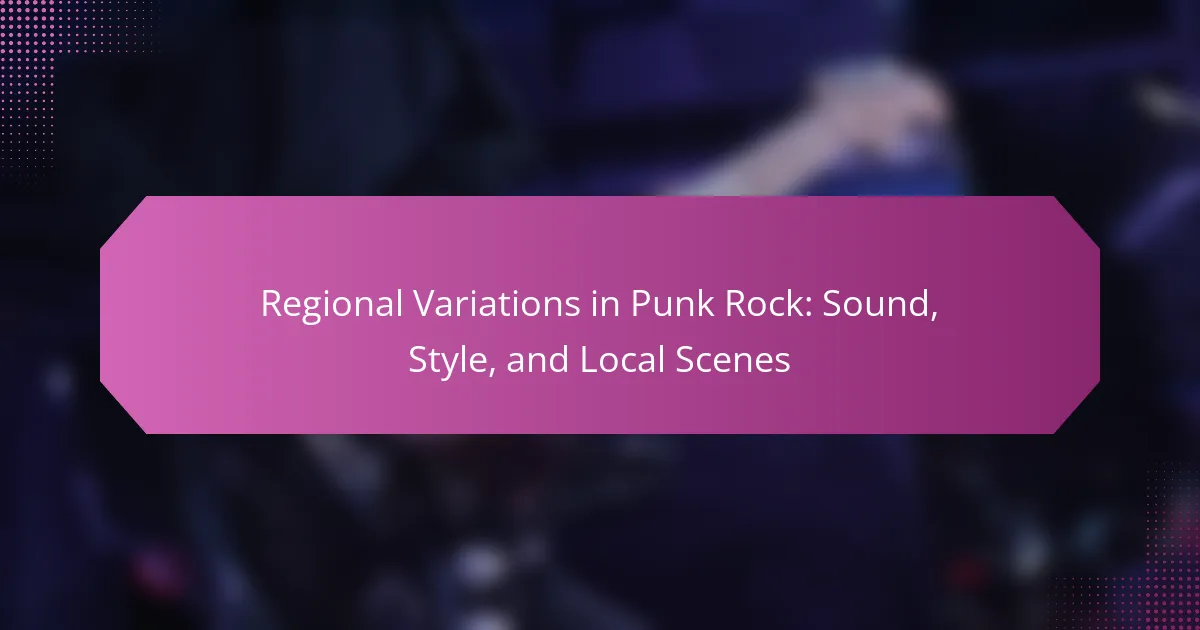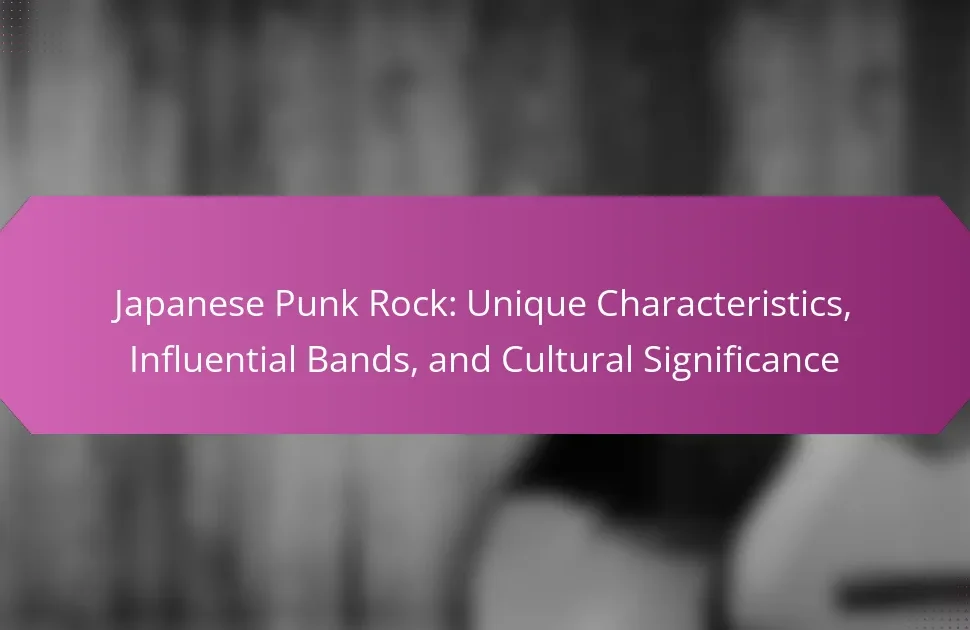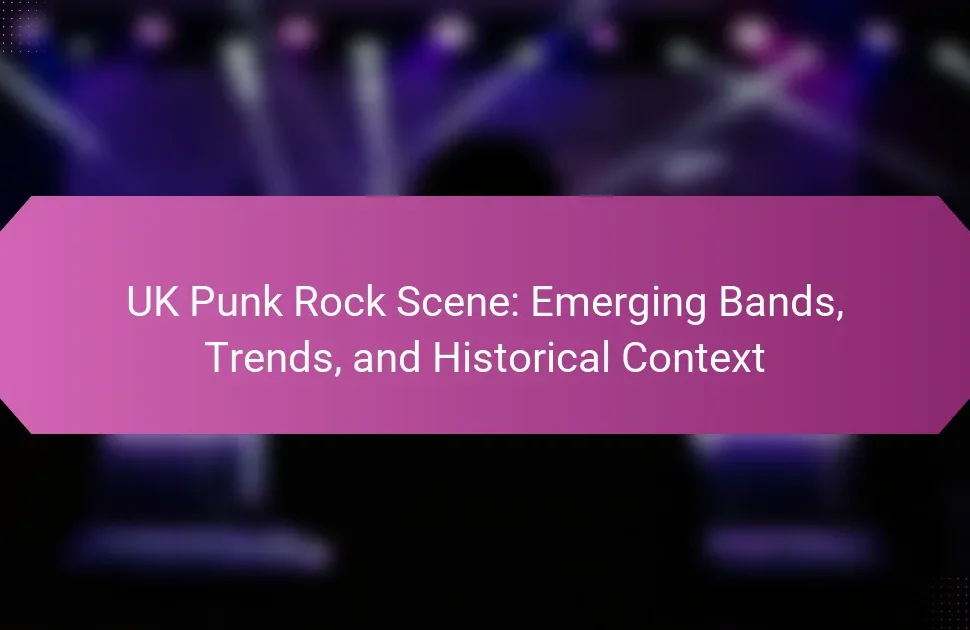Regional variations in punk rock create a rich tapestry of sound and style, influenced by local culture and social dynamics. This article explores how distinct sub-genres emerge, the unique characteristics of local scenes, and the challenges faced by regional bands. It also examines the historical context of influential punk bands and the impact of socio-political themes in lyrics. Understanding these elements reveals the ongoing evolution and relevance of punk rock across different cultures.
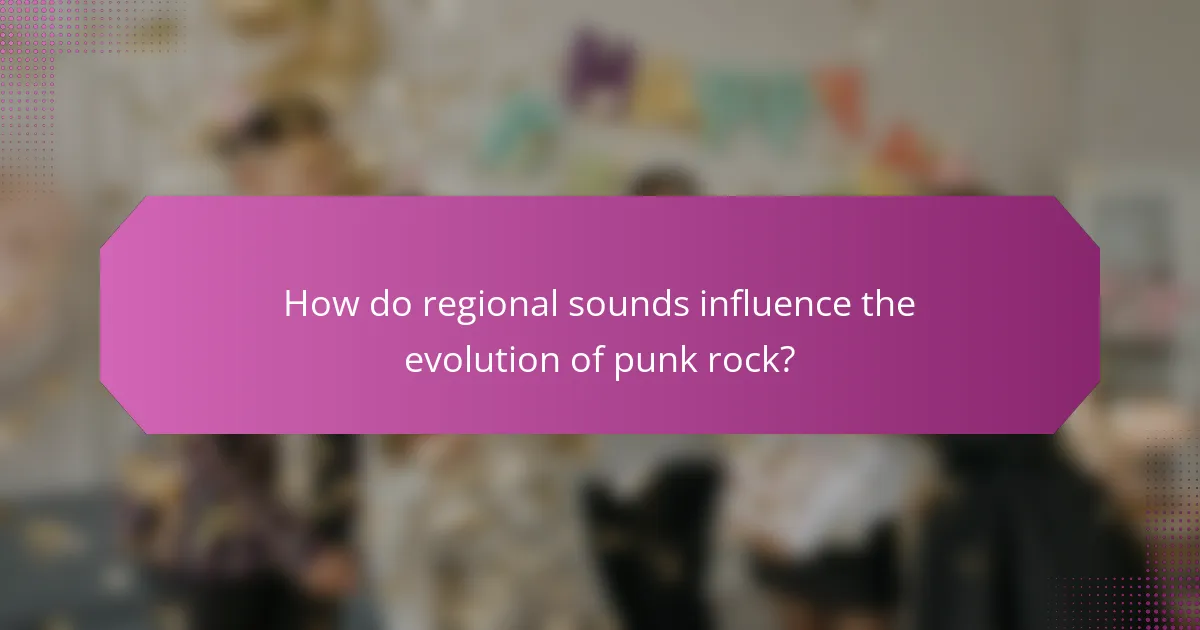
How do regional sounds influence the evolution of punk rock?
Regional sounds significantly shape the evolution of punk rock by infusing local cultural elements and distinct musical styles. Each region contributes unique characteristics, creating diverse sub-genres. For instance, the aggressive sound of East Coast punk contrasts with the melodic influences found in West Coast scenes. Local scenes foster distinct identities, with bands often reflecting the social and political climates of their areas. This regional diversity enriches punk rock, ensuring its continual evolution and relevance across different cultures.
What are the defining characteristics of punk rock sound across different regions?
Punk rock sound varies significantly across regions, shaped by local culture and influences. Each area infuses unique attributes into the genre, creating distinct styles.
For example, American punk often emphasizes speed and aggression, reflecting its roots in 1970s garage rock. In contrast, UK punk incorporates elements of reggae and ska, promoting a more melodic approach. Australian punk features a raw, energetic sound that reflects its rebellious spirit.
Regional scenes also influence lyrical themes, with American bands often addressing political issues, while Japanese punk may focus on personal and societal struggles. This diversity enriches the punk rock landscape, showcasing its adaptability and broad appeal.
Which instruments are commonly used in various regional punk styles?
Punk rock instruments vary by region, but commonly include electric guitars, bass guitars, drums, and vocal microphones. In the UK, bands often emphasize raw guitar riffs and energetic drumming. American punk typically features a strong bass presence and melodic guitar lines. In contrast, Japanese punk incorporates unique elements like synthesizers and traditional instruments, reflecting local culture. Each regional style shapes the sound and presentation of punk rock, highlighting its diverse musical landscape.
How do local musical traditions shape punk rock genres?
Local musical traditions significantly influence punk rock genres by shaping sound, style, and community dynamics. Regional variations often incorporate local instruments, rhythms, and cultural themes. For instance, the incorporation of traditional folk elements in punk from regions like Latin America creates a unique hybrid sound that resonates with local audiences. Additionally, local scenes foster distinct styles, such as the melodic punk of Southern California or the raw energy of UK punk, reflecting the socio-political climate of their environments. These influences create a rich tapestry of punk rock that varies widely across different locales.
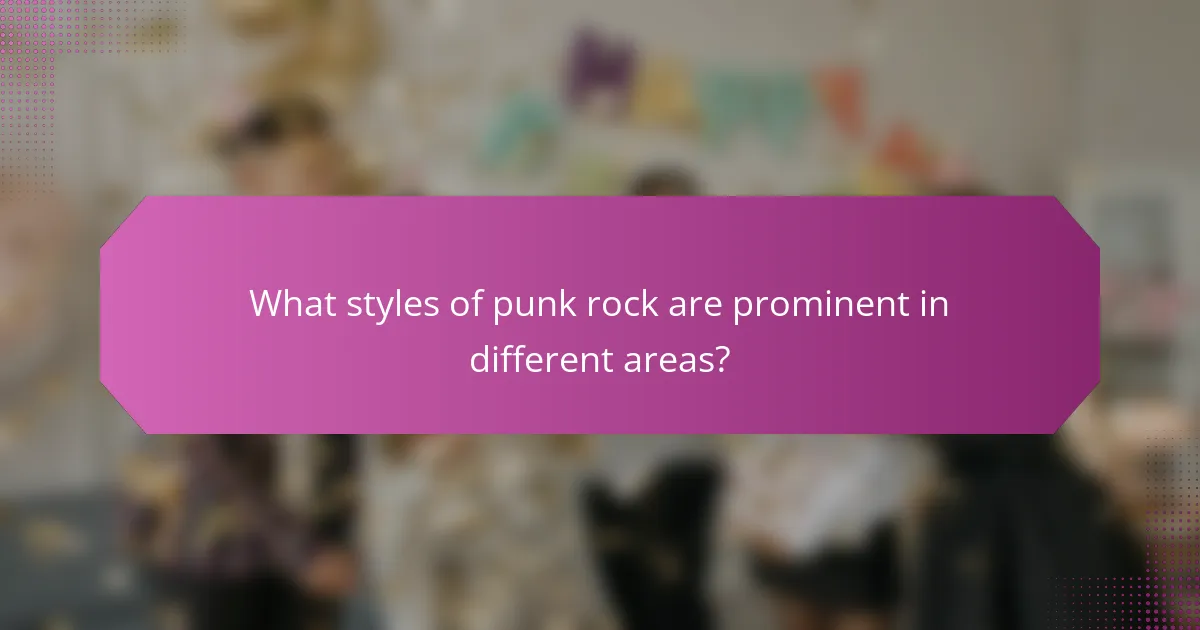
What styles of punk rock are prominent in different areas?
Punk rock exhibits diverse styles across regions, each influenced by local culture. In the United States, hardcore punk emphasizes aggression and speed, while UK punk often incorporates political themes and a DIY ethos. In Japan, the scene features a blend of melodic elements and visual aesthetics. Australia showcases a unique surf punk sound, merging punk with beach culture. In South America, bands often fuse traditional music with punk, creating distinct regional identities. Each area’s punk rock reflects its social context and cultural influences.
What are the key stylistic differences between American and British punk rock?
American punk rock emphasizes a raw, aggressive sound with a focus on rebellion and individualism, while British punk rock often incorporates a more melodic style and political commentary. American bands like the Ramones and Dead Kennedys showcase fast tempos and simple song structures. In contrast, British bands such as the Sex Pistols and The Clash blend punk with reggae and ska influences, reflecting social issues of their time. Regional scenes also differ, with American punk rooted in garage rock and DIY culture, whereas British punk emerged from the working-class environment and fashion statements.
How does the visual aesthetic of punk rock vary regionally?
The visual aesthetic of punk rock varies significantly by region, influenced by local culture and social issues. In the UK, punk often features DIY fashion, with a focus on leather jackets and spiked hair, reflecting anti-establishment sentiments. In the US, particularly in California, the aesthetic leans towards bright colors and skate culture influences, emphasizing individuality. Japanese punk incorporates elements of traditional clothing and unique hairstyles, showcasing a blend of local customs with punk ethos. Each region’s punk scene develops its distinct style, making the visual representation of punk diverse and rich.
Which fashion trends are associated with punk scenes in specific locales?
Punk scenes exhibit distinct fashion trends influenced by their locales. In London, the fashion emphasizes DIY aesthetics, featuring spiked hair and leather jackets. New York punk introduces more vibrant colors and graphic tees, reflecting its diverse cultural influences. In Los Angeles, punk style often incorporates surf elements, blending casual wear with edgy accessories. Each region’s unique attributes shape its punk identity, showcasing the genre’s adaptability and cultural resonance.

How do local scenes foster unique punk rock communities?
Local scenes cultivate unique punk rock communities by reflecting regional influences and cultural identities. Each area contributes distinct sounds, styles, and social dynamics that shape the punk experience. For example, the gritty urban landscapes of cities like New York inspire raw, aggressive sounds, while coastal towns may lean towards surf punk aesthetics.
The DIY ethos prevalent in punk allows local artists to express their specific cultural narratives, fostering a sense of belonging. This grassroots approach encourages collaboration among musicians, artists, and fans, leading to vibrant local scenes. As a result, these communities often develop rare attributes, such as unique subgenres or specific fashion trends that resonate with their environment.
Moreover, local venues serve as hubs for these communities, offering spaces for expression and connection. The interaction among local bands, fans, and promoters creates a supportive network that sustains the punk spirit. Consequently, these regional variations enrich the broader punk rock landscape, making each community’s contribution vital to the genre’s evolution.
What role do local venues play in the development of punk scenes?
Local venues are crucial in developing punk scenes by providing spaces for expression and community engagement. These venues often serve as incubators for local talent, allowing bands to perform and connect with audiences. They foster a sense of identity and belonging, reflecting the unique cultural attributes of the region. Additionally, venues can influence the sound and style of punk music, as local influences shape the genre’s evolution. For example, grassroots venues often prioritize DIY ethics, encouraging authenticity and innovation in performances.
Which festivals and events are central to regional punk cultures?
Key festivals and events central to regional punk cultures include the Punk Rock Bowling in Las Vegas, Rebellion Festival in Blackpool, and the Fest in Gainesville. These gatherings celebrate local scenes, showcasing unique sounds and styles.
Punk Rock Bowling combines music with bowling, featuring a diverse lineup of punk bands. Rebellion Festival highlights the UK’s punk history, attracting fans and artists from around the world. The Fest focuses on independent music, promoting local and emerging punk acts.
Each event reflects the unique attributes of its region, fostering community and preserving the punk ethos. These festivals not only celebrate punk music but also create spaces for cultural exchange and collaboration among fans and artists.
How do grassroots movements influence punk rock in various regions?
Grassroots movements significantly shape punk rock by fostering unique regional sounds and styles. Local scenes often emerge from community activism, leading to distinct musical expressions. For instance, in the UK, punk reflects socio-political issues, while in Latin America, it intertwines with anti-establishment sentiments. These movements create platforms for marginalized voices, influencing lyrical content and performance styles. Regional variations highlight the adaptability of punk rock, showcasing its role as a vehicle for social change and cultural identity.
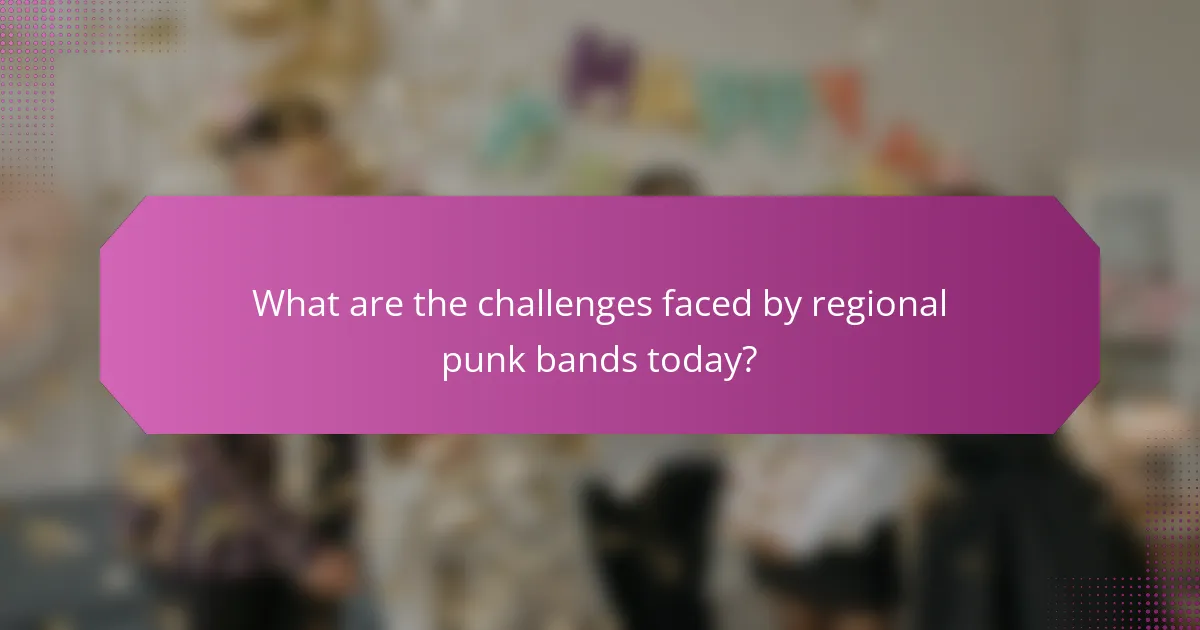
What are the challenges faced by regional punk bands today?
Regional punk bands face several challenges today, including limited access to resources, competition from mainstream music, and difficulties in reaching wider audiences. Many bands struggle with financial constraints, making it hard to produce quality recordings or tour effectively. Additionally, the rise of digital streaming has altered how music is consumed, impacting local scenes that rely on live performances for income. The unique sound and style of regional punk may also struggle to gain recognition in a market dominated by more commercial genres.
How do economic factors impact the sustainability of local punk scenes?
Economic factors significantly influence the sustainability of local punk scenes by affecting venue availability, artist funding, and audience engagement. Regions with strong local economies often support more diverse music venues, enabling punk bands to perform regularly. In contrast, economic downturns can lead to venue closures and reduced promotional budgets, limiting exposure for local acts. Additionally, disposable income levels impact audience attendance at shows, directly affecting the scene’s vitality. For instance, areas with higher unemployment may see a decline in live music participation, weakening community ties within the punk scene.
What barriers do emerging punk artists encounter in different regions?
Emerging punk artists face various barriers across different regions, impacting their growth and visibility. Factors include limited access to venues, cultural restrictions, and economic challenges.
In regions with strong local scenes, artists may struggle to differentiate their sound. In contrast, areas with less established punk communities often lack resources for promotion and collaboration. Additionally, societal norms can restrict artistic expression, particularly in conservative regions.
Economic factors play a significant role, with artists in lower-income areas facing difficulties in funding their projects. Limited access to recording studios and promotional platforms further exacerbates these challenges.
Overall, regional variations significantly shape the experiences of emerging punk artists, influencing their ability to thrive in diverse environments.
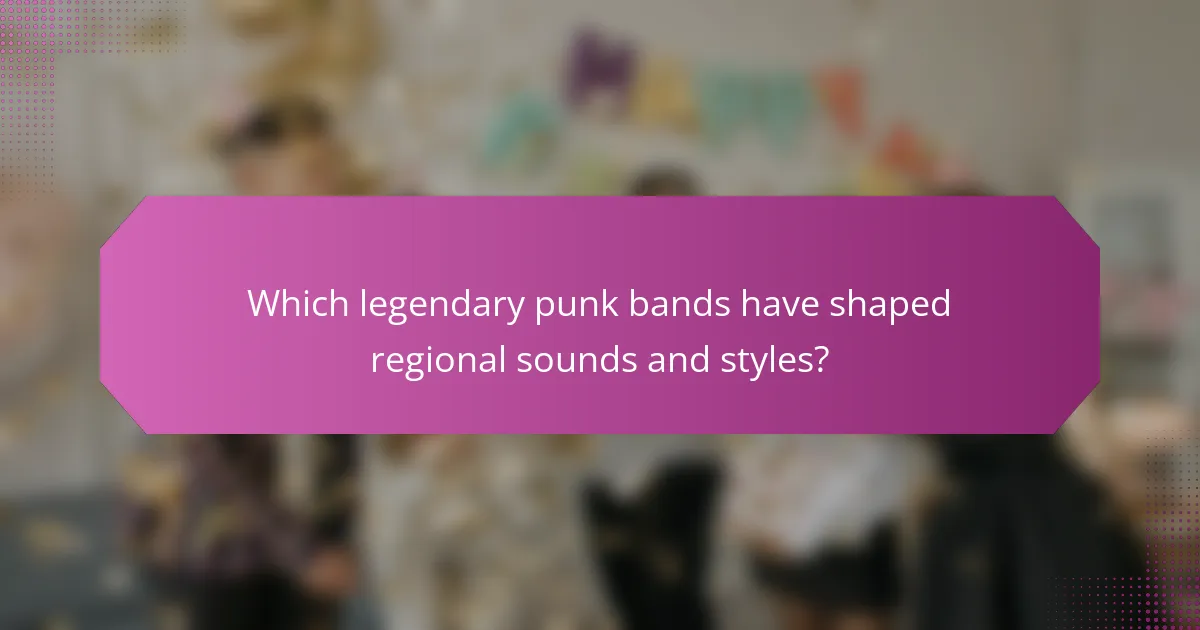
Which legendary punk bands have shaped regional sounds and styles?
Legendary punk bands like The Clash, Dead Kennedys, and Bad Brains have significantly influenced regional sounds and styles. The Clash integrated reggae and ska, reflecting London’s diverse culture. Dead Kennedys brought a distinctive California sound with satirical lyrics. Bad Brains, originating from Washington D.C., fused hardcore punk with reggae, shaping the local scene. Each band’s unique attributes contributed to the broader punk movement, showcasing how regional influences shaped their music and identity.
What unique contributions have specific bands made to their local scenes?
Specific bands have significantly shaped their local punk scenes through unique sounds, styles, and community engagement. For instance, the Ramones in New York pioneered a fast-paced sound that influenced countless local bands. In California, the Dead Kennedys introduced politically charged lyrics, reflecting local social issues. The UK’s Sex Pistols brought a raw, rebellious attitude that resonated with British youth. Each of these bands not only defined a musical genre but also fostered local identities and inspired grassroots movements within their communities. Their contributions helped establish punk rock as a vital cultural force in various regions.
How do regional punk legends influence new artists?
Regional punk legends significantly shape new artists by inspiring unique sounds and styles within local scenes. Their distinctive approaches influence emerging musicians, fostering innovation and authenticity. For instance, the raw energy of Detroit punk inspires new artists to embrace gritty aesthetics, while the melodic elements of California punk encourage catchy hooks. This cross-pollination of ideas cultivates a vibrant musical landscape, ensuring the evolution of punk rock continues. Regional scenes also provide a support network, facilitating collaborations and performances that further enrich the genre’s diversity.
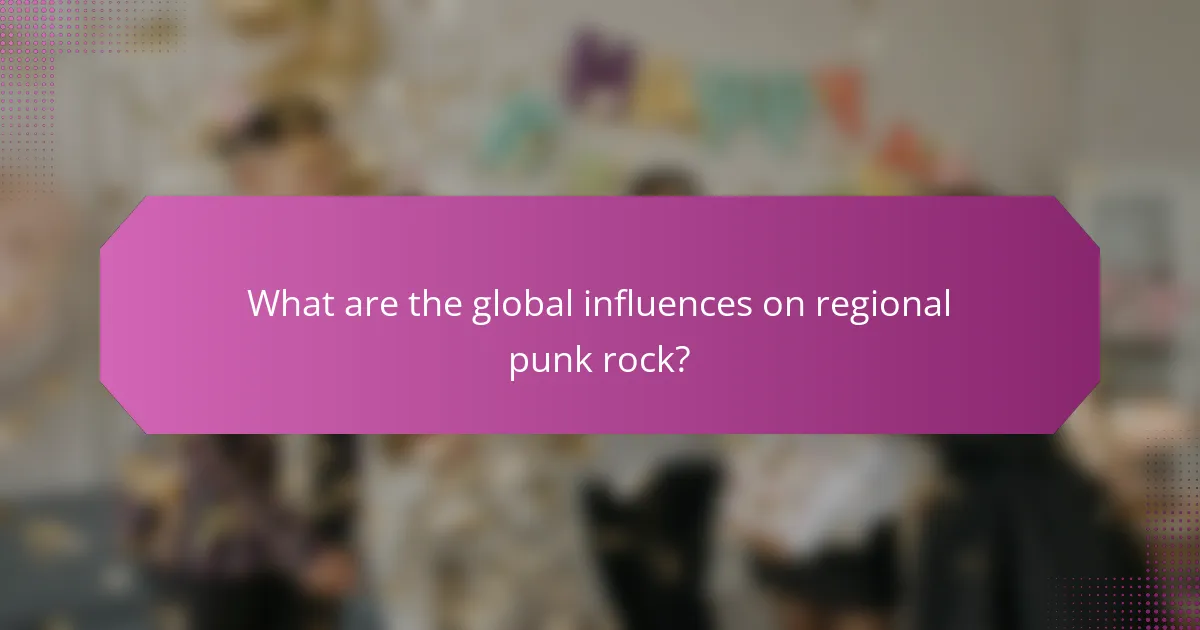
What are the global influences on regional punk rock?
Global influences on regional punk rock include socio-political contexts, cultural movements, and local music scenes. These factors shape distinct sounds and styles across different areas. For example, the punk rock scene in the UK often reflects anti-establishment sentiments, while in the US, it may highlight individualism and rebellion. Regional variations also emerge from local traditions and musical genres, creating unique subcultures within the broader punk movement. The fusion of these influences leads to diverse expressions of punk rock worldwide.
How has globalization affected local punk scenes?
Globalization has diversified local punk scenes by introducing new influences and styles. This interconnectedness allows regional variations to emerge, resulting in unique sounds and aesthetics. For example, punk in Japan incorporates traditional musical elements, while Latin American punk often reflects socio-political themes. The exchange of ideas and resources fosters collaboration among artists, enhancing creativity. As a result, local scenes thrive, adapting global trends while maintaining distinct identities.
Which international collaborations have emerged from regional punk bands?
Regional punk bands have formed various international collaborations, enhancing the global punk scene. Notable examples include the partnership between Japanese punk bands and American musicians, leading to unique cross-cultural projects. Similarly, European punk bands often collaborate with artists from South America, creating a fusion of styles that reflects their diverse backgrounds. These collaborations not only enrich the music but also foster cultural exchange and solidarity among punk communities worldwide.
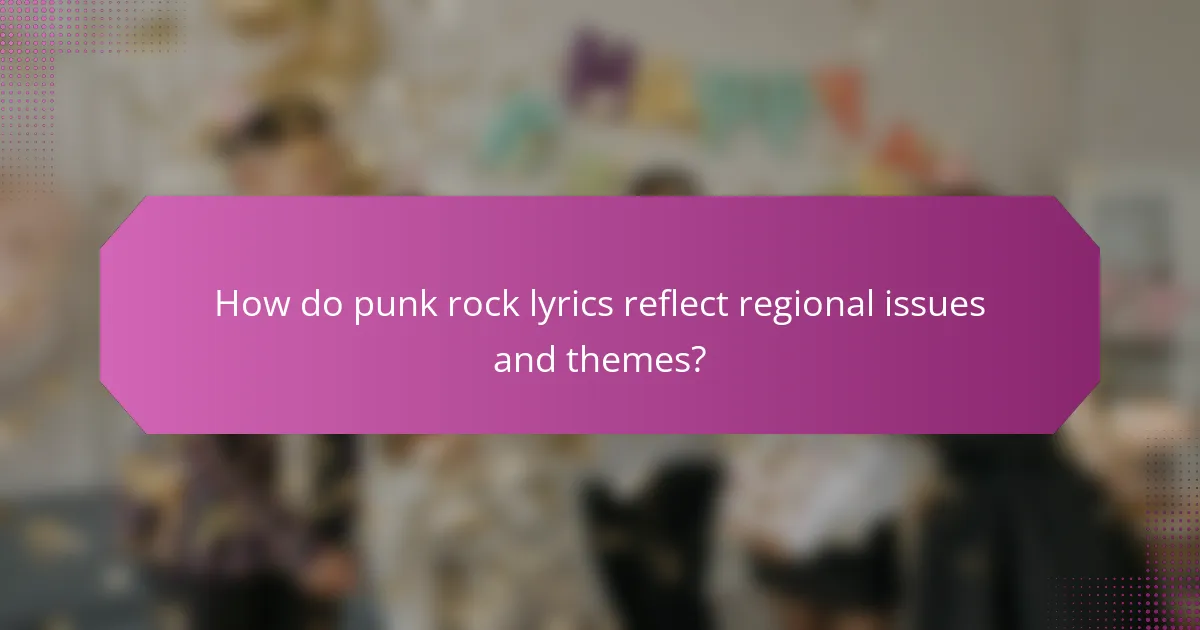
How do punk rock lyrics reflect regional issues and themes?
Punk rock lyrics often reflect regional issues and themes by addressing local social, political, and economic conditions. These lyrics serve as a voice for marginalized communities and highlight unique cultural experiences. For instance, punk bands from the UK may focus on class struggles, while bands from the U.S. might emphasize issues like police brutality or economic disparity. Regional sounds and styles also influence lyrical content, creating a diverse landscape within the punk genre that resonates with local audiences. This connection between music and place reinforces the authenticity and relevance of punk rock as a form of protest and expression.
What social and political messages are conveyed in regional punk music?
Regional punk music conveys strong social and political messages through its lyrics and themes. It often addresses local issues, reflecting the unique struggles and cultural identities of specific communities. For example, punk scenes in Latin America frequently tackle themes of government oppression and social justice, while European punk may focus on anti-fascism and immigration. These messages resonate deeply with local audiences, fostering a sense of solidarity and activism. Additionally, the raw sound and DIY ethos of punk serve as a vehicle for marginalized voices, amplifying their concerns on a broader stage.
How do local languages and dialects shape punk rock lyrics?
Local languages and dialects significantly influence punk rock lyrics by infusing regional identity and cultural nuances. These linguistic variations shape themes, slang, and storytelling in songs, making them resonate with local audiences. For instance, punk bands in different countries often incorporate local dialects to express unique social issues and cultural references. This practice not only enhances authenticity but also fosters a deeper connection with listeners. Additionally, the use of local languages can create a distinct sound and style, setting bands apart within the global punk scene.
What themes are prevalent in punk rock lyrics across different regions?
Punk rock lyrics reflect diverse themes shaped by regional influences. Common themes include rebellion against authority, social justice, and personal struggles, with variations in style and tone across different areas.
In the United States, lyrics often emphasize individualism and anti-establishment sentiments. In contrast, UK punk lyrics frequently address class struggles and political issues. Australian punk tends to incorporate humor and irony, while Latin American punk often highlights social inequality and activism.
Regional sounds also affect lyrical content. For example, California punk features surf culture references, while New York punk draws from urban experiences. These regional characteristics create unique punk scenes that resonate with local audiences.
Overall, the themes in punk rock lyrics are a reflection of cultural, social, and political contexts, illustrating how the genre evolves across regions.
What best practices can regional punk bands adopt for success?
Regional punk bands can achieve success by engaging with their local scenes, developing a unique sound, and utilizing social media effectively. Building strong community ties fosters loyalty and support. Collaborating with local artists enhances visibility and creativity. Regularly performing at local venues helps establish a dedicated fan base. Additionally, leveraging online platforms for promotion and interaction broadens reach beyond regional boundaries.
